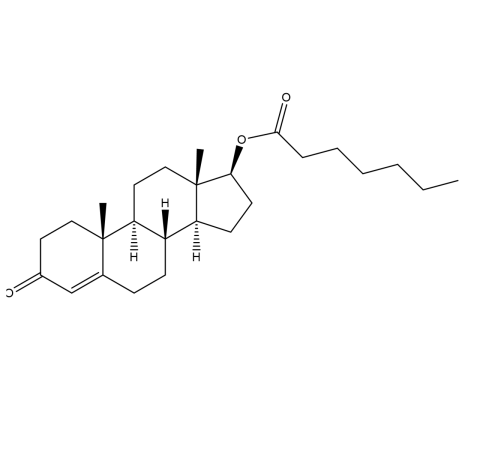Testosterone enantate is a synthetic, long-acting form of the male hormone testosterone, primarily used in testosterone replacement therapy. It is an androgen and anabolic steroid, administered via intramuscular or subcutaneous injection to treat conditions caused by a deficiency or absence of endogenous testosterone. It was described as early as 1952 and first introduced for medical use in the U.S. in 1954. It emerged in the 1950s as a longer-acting injectable testosterone option, marking a significant improvement over earlier forms of androgen replacement therapy.
BRAND NAMES
Delatestryl and Xyosted.
available as a solution for injection, primarily administered intramuscularly.
MECHANISM OF ACTION
Testosterone enantate is a testosterone prodrug administered by injection to produce a prolonged hormonal effect. Its mechanism of action begins with its gradual release and continues as it is converted into active hormones within the body.
PHARMACOKINETICS
Absorption
Testosterone enanthate is absorbed slowly following an intramuscular or subcutaneous injection, creating a long-lasting "depot" effect. The absorption and release process is designed to sustain testosterone levels for several weeks after a single dose.
Distribution
Following intravenous administration, testosterone has a volume of distribution of approximately 1 L/kg.
Metabolism
Testosterone enanthate is a prodrug administered by injection, gradually released into the bloodstream from an oil-based depot. The enanthate ester is then hydrolyzed by enzymes, which releases free and active testosterone. This free testosterone is primarily metabolized in the liver, where it can be converted into dihydrotestosterone (DHT) by the 5α-reductase enzyme or aromatized into estradiol. The metabolites are subsequently conjugated with glucuronic acid and sulfuric acid and are primarily excreted in the urine.
Excretion
Roughly 90% of a testosterone dose administered intramuscularly is excreted in the urine, with about 6% eliminated via the feces.
PHARMACODYNAMICS
Testosterone enanthate is a long-acting ester of the natural androgen testosterone, which acts as a prodrug to deliver sustained levels of testosterone to the body. Its primary pharmacodynamic effects result from its conversion to and binding to the androgen receptor, and its subsequent metabolism into other active hormones.
ADMINISTRATION
Testosterone enanthate is administered via injection, with the two primary methods being intramuscular (IM) and subcutaneous (SQ). The specific administration method, dosage, and frequency depend on the patient's condition, diagnosis, and response to treatment.
DOSAGE AND STRENGTH
Testosterone enanthate is available as a solution for injection, typically administered either intramuscularly (into a muscle) or subcutaneously (under the skin).
A dosage of 50 to 200 mg administered every 2 to 4 weeks over a period of 4 to 6 months.
DRUG INTERACTIONS
Testosterone enanthate interacts with specific medications, including oral anticoagulants, corticosteroids, and insulin. Taking it with oral anticoagulants, such as warfarin, increases bleeding risk and requires close monitoring. Concurrent use with corticosteroids or ACTH can cause increased fluid retention (edema), especially in patients with heart, liver, or kidney disease. Additionally, testosterone enanthate can alter glucose metabolism in diabetic patients, potentially reducing the need for insulin and increasing the risk of low blood sugar.
FOOD INTERACTIONS
As an injectable medication, testosterone enanthate has no direct food interactions. However, a balanced and healthy diet remains important to manage potential side effects and support overall hormonal health. Patients receiving testosterone replacement therapy are advised to maintain a healthy weight, manage cholesterol with a fiber-rich diet, and limit or avoid alcohol. It is especially important to discuss any changes to diet and exercise with a doctor, particularly if you have pre-existing conditions affecting the heart, liver, or kidneys.
CONTRAINDICATIONS
Testosterone enanthate is contraindicated in individuals with a hypersensitivity to the drug or its ingredients, as well as men with breast or prostate cancer. Other serious health conditions also prevent its use due to the risk of exacerbating existing problems.
SIDE EFFECTS
Injection site reactions.
Skin problems.
Fluid retention.
Breast enlargement.
Mood changes.
Sleep disturbance.
Changes in sex drive.
Cardiovascular issues.
Fertility issues.
Liver problems.
Increased red blood cell count.
OVER DOSE
An overdose of testosterone enanthate can cause severe and potentially life-threatening side effects, especially with chronic abuse.
Acne and oily skin.
Mood changes, including aggression, irritability, or euphoria.
Insomnia and sleep disturbances.
Gynecomastia (enlarged or painful breasts in men).
Retention of fluid, causing swelling in the hands, feet, or ankles.
Headaches.
Weight gain.
Pain and swelling at the injection site.
Increased or decreased sex drive.
TOXICITY
Testosterone enanthate toxicity, which is caused by overuse or abuse, can lead to severe and potentially irreversible health complications affecting the cardiovascular system, liver, and mental health. Taking more than a prescribed dose can cause serious side effects, addiction, and withdrawal symptoms.






